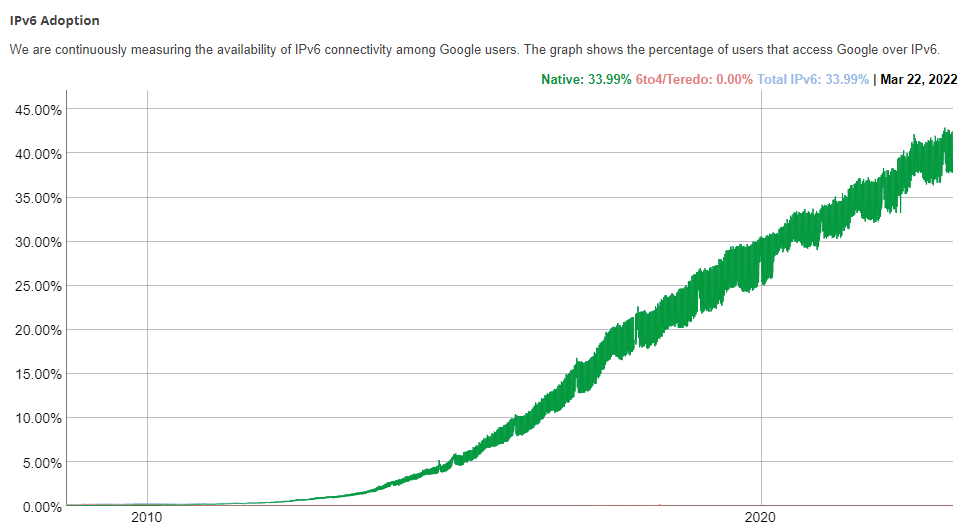The migration from the world of Internet Protocol Version 4 (IPv4) to IPv6 began to be discussed back in the early 2000s when the issue of IPv4 address exhaustion has been intensified. Over the past two decades, the number of Internet connections has grown exponentially and continues to increase at a breakneck pace with the spread of mobile devices and IoT.
Nevertheless, IPv4 still holds its ground, at least due to the widespread use of NAT routing. In this article, we'll discuss the transition to IPv6 in detail, the reasons why it’s taking so long, and what opportunities this technology may provide in the future.
The history of IPv6
IPv4 provides 232 or about 4.3 billion addresses. If in the 80s, when the IPv4 standard was being developed, this figure seemed enormous, today we are witnessing that the number of devices in the global network has long surpassed this threshold. By the end of 2017, all the regional registries announced the exhaustion of available IPv4 addresses.
The recognition of the address space exhaustion started in the early 1990s. As such, the Internet Engineering Task Force (IETF) began to develop a new protocol that would provide the world's population with IP addresses for generations to come. For this purpose, the address length was increased from 32 to 128 bits, acquiring the following format:
1006:0000:0000:0000:0002:0600:400f:326a
or a shortened one:
1006::2:600:400f:326a
In the early 2000s, IPv6 was standardized, and in 2008 Google began actively implementing IPv6 in its internal networks. A few years later, in 2012, IPv6 was officially launched to encourage organizations and providers to adopt the new protocol. Many companies participated in the launch, including Google, Facebook, and Cisco.
IPv6 adoption continued to grow in the mid-2010s, but it still accounted for less than 10% of Internet traffic. When IPv4 addresses were exhausted, the transition to IPv6 became more critical. Companies began to adopt IPv6 more aggressively to prepare for the future.
As of 2023, IPv6 adoption is measured to be only a little over 40%.

Source: Google IPv6 adoption
Why haven’t we transitioned to IPv6 yet? Despite the obvious benefits of the new protocol and the need for new addresses, there are a number of factors hindering adoption.
IPv6 adoption challenges
One of the main reasons why IPv6 is still not widespread is that it requires an upgrade or complete replacement of hardware and software to work properly. This includes upgrading routers, switches, and other network equipment as well as updating software and operating systems.
Another challenge is that IPv6 is not backward compatible with IPv4. As such, during the transition period, both protocols must be supported in parallel, which is very costly and may pose a security risk.
Moreover, many network administrators and corporate leaders have a limited understanding of this protocol. IPv6 differs significantly from IPv4 and requires a different approach to addressing, routing, and security. Administrators may not have the expertise or resources for effective adoption, while corporations may not see the value in investing in new training or hiring new staff to manage the transition.
In addition, many companies still do not have sufficient incentives to migrate to IPv6. Most websites and online services still support IPv4, so there is little immediate benefit to end users.
As a result, the cost and complexity of this transition can seem overwhelming to organizations, even if they have relevant expertise. This is why many of them are hesitant to implement IPv6 unless it is absolutely necessary.
So, what is next?
Despite the above, most experts agree that the widespread transition to IPv6 is only a matter of time. All offices of leading IT corporations like Google, Facebook, and Amazon already use IPv6 exclusively.
In addition to enlarged address space, IPv6 has a number of other advantages, including:
- Improved routing, namely the support for hierarchical routing, which allows more efficient use of network resources.
- Enhanced security: IPv6 includes built-in security features such as IPsec, making it more difficult for hackers to intercept or modify network traffic. Moreover, IPv6 addresses are harder to spoof than IPv4 ones.
- Better traffic management: IPv6 incorporates support for flow labels and traffic classes, allowing network administrators to prioritize different types of traffic and improve service quality.
- SLAAC (Stateless Address Autoconfiguration) makes network administration much easier.
Undoubtedly, migrating from IPv4 to IPv6 requires a thorough understanding of IPv6 and its features. Companies may also need to make changes to their applications and services to ensure that they work properly with IPv6. While costly and time-consuming, adopting the protocol opens up new opportunities for further development.
At 3HCloud, we recognize the importance of transitioning to modern technologies, which is why we offer full support for both IPv4 and IPv6.















